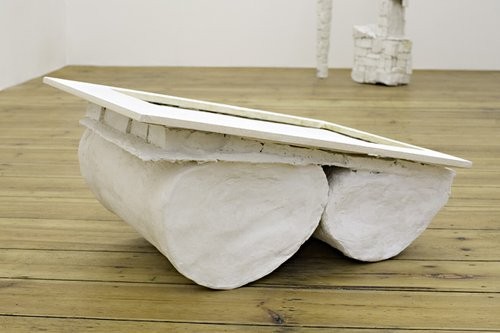Sarah Szczesny
05 Dec 2009 - 30 Jan 2010
SARAH SZCZESNY
“Cabin Fever Press”
by Hili Perlson
Cabin Fever Press
Galerie Cinzia Friedlaender
Potsdamer Straße 105, 10785 Berlin, Germany
December 5, 2009 - January 30, 2010
In her first solo show in Berlin, young German artist Sarah Szczesny is showing seven mixed-media sculptures and one large scale drawing in an arrangement which aptly conveys the contained yet maniacal restlessness of cabin fever. When walking through the gallery’s rectangular larger room, the sculptures are laid out in a floor pattern that forces the viewer to move around cautiously and be highly aware of the spatial restrictions around them. The smaller room houses the 2.8 x 3 meter drawing which takes up nearly an entire wall. Here, the viewer is invited to move back and forth in the small room in order to take in the entire piece all at once or to see its very fine and intricate details.
Intricacy of detail describes Szczesny’s work in general. The color palette of her larger sculptures consists of various shades of white and their recondite physicality elicits a visceral recognition of controlled bursts which remain contained within their shapes. “Pronounce,” the first sculpture the viewer encounters, is an elongated, thin column with a buttress in the shape of an upside down ‘L’ jutting out into the room. The sculpture’s elegant lines frame the pronounced expressiveness in a controlled form. This two meter tall meter piece displays a patchwork-like outer shell of numerous small rigid blocks, resembling a reptilian exterior that is repeated in much of Szczesny’s work. In “The Curse is Beginning to Work,” a flaky patina in the shape of a hammer slams its way down and out of a perfectly framed rectangle.
The ink-on-paper drawing “Untitled” is made up of 12 segments, although the spatial boundaries do not seem definite and appear as if they could continue to multiply. Alll borders are transgressed as the drawing’s architectural shapes pop up throughout the piece. These abstract shapes are augmented with fine, hardly visible details that could be mistaken for tiny faults but are in fact the artist’s meticulous hand transforming the whiteness of the paper into a site of contained explosions.
“Cabin Fever Press”
by Hili Perlson
Cabin Fever Press
Galerie Cinzia Friedlaender
Potsdamer Straße 105, 10785 Berlin, Germany
December 5, 2009 - January 30, 2010
In her first solo show in Berlin, young German artist Sarah Szczesny is showing seven mixed-media sculptures and one large scale drawing in an arrangement which aptly conveys the contained yet maniacal restlessness of cabin fever. When walking through the gallery’s rectangular larger room, the sculptures are laid out in a floor pattern that forces the viewer to move around cautiously and be highly aware of the spatial restrictions around them. The smaller room houses the 2.8 x 3 meter drawing which takes up nearly an entire wall. Here, the viewer is invited to move back and forth in the small room in order to take in the entire piece all at once or to see its very fine and intricate details.
Intricacy of detail describes Szczesny’s work in general. The color palette of her larger sculptures consists of various shades of white and their recondite physicality elicits a visceral recognition of controlled bursts which remain contained within their shapes. “Pronounce,” the first sculpture the viewer encounters, is an elongated, thin column with a buttress in the shape of an upside down ‘L’ jutting out into the room. The sculpture’s elegant lines frame the pronounced expressiveness in a controlled form. This two meter tall meter piece displays a patchwork-like outer shell of numerous small rigid blocks, resembling a reptilian exterior that is repeated in much of Szczesny’s work. In “The Curse is Beginning to Work,” a flaky patina in the shape of a hammer slams its way down and out of a perfectly framed rectangle.
The ink-on-paper drawing “Untitled” is made up of 12 segments, although the spatial boundaries do not seem definite and appear as if they could continue to multiply. Alll borders are transgressed as the drawing’s architectural shapes pop up throughout the piece. These abstract shapes are augmented with fine, hardly visible details that could be mistaken for tiny faults but are in fact the artist’s meticulous hand transforming the whiteness of the paper into a site of contained explosions.

